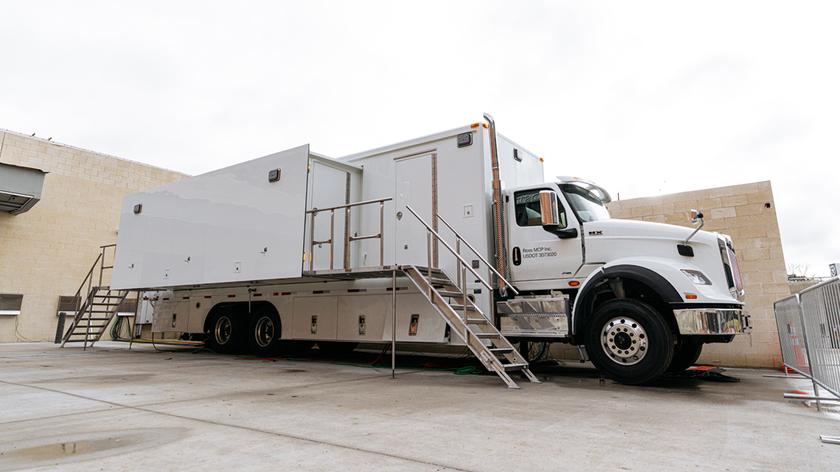A/V 104: Time-Domain FX and Reverb
This column will be devoted to the basics of time-domain signalprocessing effects, most notably reverb.
Happily, this is fairly easy to get a handle on, and its use for most television production is pretty straightforward.
Once again, I hope you find it useful, and/or that you can pass the column on to some of your video colleagues.
REVERB & AMBIENCE
Reverberation and ambience are absolutely essential acoustical behaviors in everyday life. They are inescapable facets of our sonic landscape, and we use them, subconsciously, as vital cognitive tools to assist us in perceiving the reality of our environment at any given moment, as well as perceiving our place in that landscape and the identity and location of other persons and objects.
Because microphones do not "hear" in the same way that humans do, the detection of reverberance and ambience by microphones when making a recording is often undesirable, and we regularly take considerable pains to suppress or minimize it. This is particularly true in video production.
Sometimes, however, we wish to have a sense of space in a recording, and so we desire to add reverberance back to our dry recordings. Toward that end, we have invented a series of effects boxes called reverbs that allow us to do exactly that. A reverb generates a series of reiterations of the signal over time to mimic the acoustical behavior of an enclosed space.
There are two parts of this, due to the way our hearing works.
First, there is a volley of what we call "early reflections," which follows the direct sound that we hear during the first 50 milliseconds after the direct sound has reached our ears.
These are perceptually fused with the direct sound and we do not consciously perceive them as reflections or echoes, but rather as an enrichment and "widening" of the direct sound source. We call this stuff "ambience."
Usually, this is all we get when we listen in small rooms. In large rooms, it usually constitutes the "first part" of the reverberance process. In large rooms, after 50 milliseconds, we begin to hear the reflections from the room coming back to us as a wash of sound dying away over time.
The amount of time it takes for the sound to decay or die away is called "reverb time."
In general, the larger the room, the more time it takes for sound to die away. For a given space, the more sound-absorbent materials that are in the space or on the walls, the shorter the reverb time will be. We call this a "drier" room, as opposed to a "wetter" room; sometimes we refer instead to "live" (reverberant) or "dead" (nonreverberant) spaces.
When we do this with reverbeffects devices, we usually generate ambience with a few discrete short
delays (typically between 15 and 35 milliseconds ) and/or extremely short reverb times; we generate the sense of reverberance by using a longer onset time for the reverberance (called "predelay") and much longer reverb times (typically 1.5 to 3 seconds).
The important thing to keep in mind is that the ambience adds a sense of solidity and palpable body to the sound, while reverberance adds a sense of spaciousness trailing after the sound.
AT THE HEART OF STEREO
Ambience and reverberance are inherently spatial, and in many respects they are at the heart of the power of stereo. It is reasonable to think of reverb as the primary stereo enhancer--indeed, many old mono records are reissued in "stereo' by simply adding stereo reverb.
Ambience is even more striking. We don't hear it as such, but it is profoundly evident that there is some sort of "roominess" enveloping an otherwise dry sound when we add early reflection ambience.
Therefore, we can think of ambience and reverb as "adding stereo" to a mono signal or signals. It can be a very handy tool.
Ambience can be easily generated in a digital audio workstation these days by adding some short delays (20-35 ms) panned left and right.
They should be slightly different times and barely audible. Such an application is called a "spreader" in multitrack mixing.
Good digital reverbs can be fairly expensive. If they reside in software, they can use up most of the computational capacity of a computer. I find them absolutely seductive--I'm a reverb junkie! That said, less is more, and my advice is that you use the effect sparingly, especially in live production.
THE MEANING OF IT ALL
In the television world, post-production reverb has a profound place in the production of dramatic and musical shows, as well as commercials. It has almost no place in talk shows, newsgathering, voice-overs and general-purpose video production.
As I've mentioned in previous columns, we have made a production tradition of absolutely bone-dry voicetracks and almost any live on-camera sound. We have become so accustomed to such a sound quality that when ambience is added to such material it usually sounds quite odd.
This means you generally can't go wrong by leaving reverb out. Nonetheless, there are moments when it can really help. I remember the live stereo ambience that Ron Estes got on those priceless Johnny Carson stereo broadcasts that I wrote about recently. It added a liveness and zest to the proceedings that was simply stellar.
So use reverb sparingly, but use it to good effect. Keep it in your effects toolbox for when you need to make a point about being in stereo, or in an ambient or reverberant space. It's easy to use and it really works. Enough said.
Thanks for listening.
Get the TV Tech Newsletter
The professional video industry's #1 source for news, trends and product and tech information. Sign up below.












